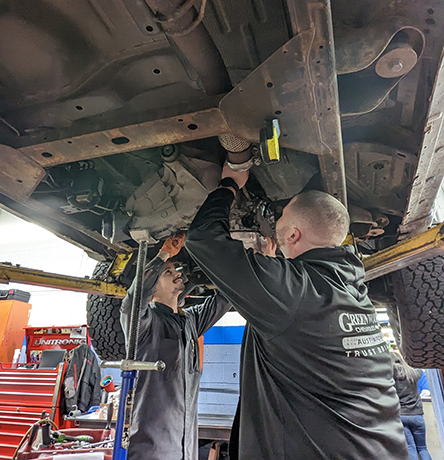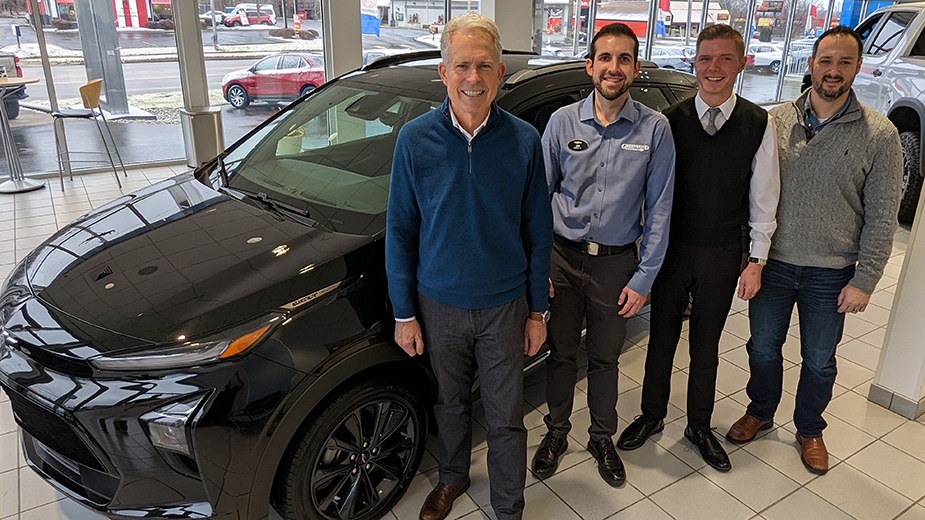AUSTINTOWN, Ohio – Greg Greenwood marvels at how the automobile industry has changed from nearly 50 years ago, and is even more excited about where it’s headed in the next 50 years.
“I sold my first car in 1975,” recalls Greenwood, today the president of Greenwood Chevrolet in Austintown. “It was a used Chevrolet Caprice station wagon. Can you imagine the difference over the last 50 years?”
Then, the Greenwood family dealership, founded by Greenwood’s father, Wayne “Bud” Greenwood, was based in Warren along U.S. Route 422. In 1980, it relocated to a new showroom and lot at 4695 Mahoning Ave. in Austintown, where it still stands.
Now the dealership is transitioning, along with General Motors and its venerable Chevrolet brand, to a market that was unthinkable when Greenwood first sold that used Caprice. As GM advances toward its goal of producing a zero-emission lineup of new vehicles by 2035, the Greenwood dealership is positioning itself ahead of the curve.
The market’s transition, however, will take some time, Greenwood says. Moreover, just because EV production will ramp up doesn’t mean that the volume of vehicles with internal combustion engines is going to decline anytime soon.
As it stands, the adoption rate in the United States for EVs is approximately 5%, Greenwood says. “You’re going to see it grow slowly, but surely,” he says. It won’t be for another three-to-five years until the market really begins to accelerate, he says.
At the same time, Chevrolet has no intention of easing off the gas pedal when it comes to combustion engine vehicles, Greenwood says. In January, the dealership boasted its highest inventory in 24 months, as the industry rebounds from supply-chain issues such as a shortage of semiconductors that plagued manufacturers last year. “But every one of those is an ICE [internal combustion engine] product,” he says. “Inventories are growing, but not on the EV side yet.”
Indeed, Greenwood says that should GM meet all of its goals after the next three-to-five years, EVs would represent approximately 15% of its market. That’s in addition to static or increased sales of ICE vehicles.
“The volume of ICE vehicles will at least stay the same,” Greenwood says. “But, they’re planning for growth.”
It all points to a comfortable coexistence of EVs and combustion engine-vehicles as the industry drives toward what is likely an all-electric future. In the meantime, manufacturers, dealerships, and transportation networks all will require significant changes to accommodate EVs.
Upgrading the country’s infrastructure with new EV charging stations and networks is paramount before mainstream America embraces widespread adoption of electric vehicles, Greenwood says. Also, dealerships would need to upgrade tooling in their service departments, as well as train technicians on how to safely perform maintenance on EVs.
“Training needs to happen. There’s a tremendous amount of infrastructure that needs to happen,” Greenwood says. “So, we’re at the very early edge of this curve.”
While EV adoption is strong on the West Coast, it has yet to catch on in
the Midwest, Greenwood says.
“It’s also going to be a little different business model,” he says. Orders for new EV products are likely to originate online in which customers would first need to place a reservation for new EVs.
“It’ll be awhile before inventories pile up,” he says. “We’ll have to adapt to the new sales process and let customers get comfortable with that.”
Greenwood says Chevrolet is nevertheless ready to roll out some of the most exciting products in the EV space this year. By mid-to-late summer, the dealership should have its first 2023 Blazer EV on site. In the fall, consumers can expect the 2024 Equinox EV and the much-anticipated Silverado EV from Chevrolet
“People are already in line for the Silverado,” Greenwood says. “That’s going to be huge.” After GM announced the new Silverado EV, the first edition of the vehicle sold out in 12 minutes, he says.
Yet the bread and butter of the EV market is not those buyers who consider EVs because they crave the latest and greatest, Greenwood notes. Fleet sales are important to work trucks such as the Silverado, but developing the strong, mainstream, sustainable EV consumer market will depend on capturing those who believe that purchasing an electric vehicle simply makes sense.
“Chevy needs to reach the pragmatists,” Greenwood says, stressing the long-term savings consumers could realize on fuel and maintenance costs on models with a reasonable price point. “Chevrolet can’t afford to sell a $90,000 entry-level EV. They need an early majority for that big swath of buyers.”
In response to what likely will be a flood of new questions from potential electric-vehicle customers, the dealership hired Kevin Lawson to the newly created position of EV specialist.
“My role is to look at the sales floor, day-to-day, and to help other sales people work with a prospective customer,” Lawson says.
Among the first questions Lawson asks customers when they inquire about buying an EV is what convinced them to make the leap to electric.
“Only a handful are motivated by the reduced impact on the environment,” he says. Some like the idea of owning something new that can accelerate from 0-60 miles per hour in six seconds.
“A lot are interested in the potential savings in maintenance and gas,” he says.
Most EV buyers that Lawson has dealt with represent an older age demographic that dispells the notion that the market’s sweet spot – at least in the Mahoning Valley – isn’t composed of 30 to 40 year-olds.
“Most of my customers are over 50,” Lawson says. “One of the oldest was 78, who purchased a new Chevrolet Bolt.”
Consumers are also much more educated when it comes to EVs, says Jim Conlin, new-car manager at Greenwood. “They’ve done their homework,” he says.
“They know they want an EV. Now, it’s just a matter of finding the right car for them.”
Chevrolet has been limited thus far as to what it can sell in this market, Conlin says. The Chevrolet Bolt EV and EUV are the only two EV models for sale in the brand’s lineup. The introduction of the Blazer, Silverado and Equinox allows for more options in this marketplace.
Still, Lawson says customers have plenty of questions and it’s important that they understand the full implications of buying an EV. His job is to provide them with as much information as possible and perhaps ask questions that the sales team or the consumer might not have considered.
“I don’t want someone to make a big-ticket purchase and find out they missed something or something they should’ve asked about but didn’t,” Lawson says.

Service training at dealerships is another important measure that is integral to the success of EVs, says Sean Greenwood, service manager. The shift to EVs presents a whole new set of challenges, he says.
These range from upgrading technicians’ skills toward EV certification to purchasing new tools necessary to provide proper maintenance on the vehicles.
“We’re working right now to make sure we have all of the special tools,” he says. “Safety is the big thing – learning different procedures on how to take out the battery, specific gloves we need that are inspected every six months. There’s a lot that goes into it.”
Training is accomplished through a combination of online and hands-on instruction, he says.
Greenwood can handle batteries for vehicles such as the Bolt, he says. However, the batteries are much larger in new products such as the Silverado EV and will require substantial upgrades and training.
The dealership has two certified technicians on staff and more will be accredited as demand for EVs ramps up, Sean Greenwood says. Some are also likely to pursue master technician certification through GM’s program. “It’s exciting to see this really cool technology coming,” he says.
Among his duties will be to oversee the installation of fast EV chargers at the Austintown store, as well as at another Greenwood Chevrolet dealership in Hubbard that is not yet authorized to sell EVs.
Also, the dealership will participate in the GM dealer’s EV charging program, in which dealers are able to partner with a private installer and place five fast EV chargers in areas of the community.
For Greg Greenwood, the shift to EVs is grounded in the same core values and culture that were established during the early years of his family’s dealership.
“A long time ago I realized that I can’t sell all these cars,” Greenwood says. “We’ve had to create the best team and it’s fun to watch that.”
As the adoption of EVs accelerates, Greenwood says it’s imperative that Chevrolet and its dealerships get it right from the very start.
Greenwood’s team, he adds, is dedicated to building customer relationships that he projects will last well beyond this dynamic change.
“We can’t drop the ball when it comes to customer expectations,” he says. “We have to make sure we deliver.”
EDITOR’S NOTE: On the Road to EVs is a quarterly series of stories sponsored by Greenwood Chevrolet. Comprehensive coverage of how GM and Greenwood are transitioning to EVs is updated weekly at BusinessJournalDaily.com/on-the-road-to-evs-greenwood/
Pictured at top: Greg Greenwood, president of Greenwood Chevrolet in Austintown, and his team stand before a Chevrolet Bolt EUV. From left: Greenwood; Jim Conlin, new-car manager; Kevin Larson, EV specialist; and Sean Greenwood, service manager.
